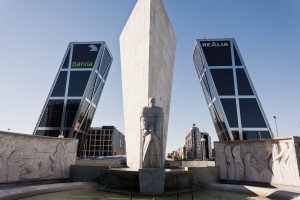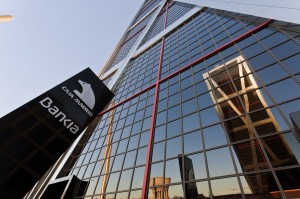
With the Spanish government accepting an EU bailout offer of up to €100 billion to recapitalize its ailing banking system, images of the country’s major financial institutions have been flashed repeatedly across global news reports. Perhaps the most displayed image has been that of the headquarters of Realia and troubled bank Bankia: a pair of towers that lean dramatically over the Paseo de la Castellana, a major Madrid thoroughfare.
The Puerta de Europa towers were designed by the American firm of Johnson/Burgee Architects. Philip Johnson (1906-2005) had been an early proponent of the International Style, introducing Americans to European architects such as Mies van der Rohe and Le Corbusier through his work at MoMA’s Department of Architecture (Johnson later worked with van der Rohe on New York City’s Seagram Building).
During the late 1960s, Johnson teamed up with John Burgee and together they designed a number of high-rises that show a move away from the strict Modernism of Johnson’s early career, including the Transco Tower (now Williams), in Houston (1983) and the AT&T Headquarters (now Sony), in New York (1984). In 1989, Johnson and Burgee were commissioned by the Kuwait Investment Office (KIO) to design a pair of towers that would form part of the development of a new business district at the northern end of Madrid.
Encountering an existing subway interchange at the Plaza de Castilla that prevented high-rises from being built directly alongside the street, the architects, with help from structural engineers Leslie E. Robertson Associates, decided on a unique solution: offsetting the towers by tilting them at 15 degrees towards each other. At 115 meters, these towers lean 30 meters from their respective bases, a feat that is accomplished with help from large concrete cores as well as counterweights and cables set on the opposite sides of the inclinations.
Leaning over a major boulevard would be striking enough but the architects chose to make the design’s skeleton clearly visible on both structures by outlining their perimeters in stainless steel, then using red on its horizontal-vertical cladding along a dark glass curtain wall. The result is a pair of buildings that are connected through visual cues and can also be read as a symbolic puerta, or gateway, to Europe.
In the 1980s, the Kuwait Investment Office (KIO), a London-based subsidiary of Kuwait’s Investment Authority, had acquired a number of Spanish companies in areas as diverse as chemicals, real estate and fertilizer, forming Grupo Torras by 1988. Bolstered by a country newly inducted into the European Union, it quickly became one of the largest companies in Spain.

But by 1992, Grupo Torras was in receivership and at the centre of the largest financial scandal of its time with the equivalent of billions of US dollars, lost, stolen or otherwise squandered by mismanagement. At the time, the unfinished “KIO Towers” had come to symbolize the end of a 1980s economic boom in dramatic fashion.
Even the architectural firm originally assigned the project did not survive intact through the 1990s. Philip Johnson had been eased out of Johnson/Burgee by 1991 and by the middle of the decade John Burgee would declare bankruptcy, effectively ending his architectural career.
With Bankia at the heart of Spain’s financial troubles and by extension the euro zone’s economic crisis, perhaps the leaning towers straddling the northern end of Madrid’s Castellana are now fulfilling their role as a gateway to Europe more than ever before.
Leave a Reply
You must be logged in to post a comment.